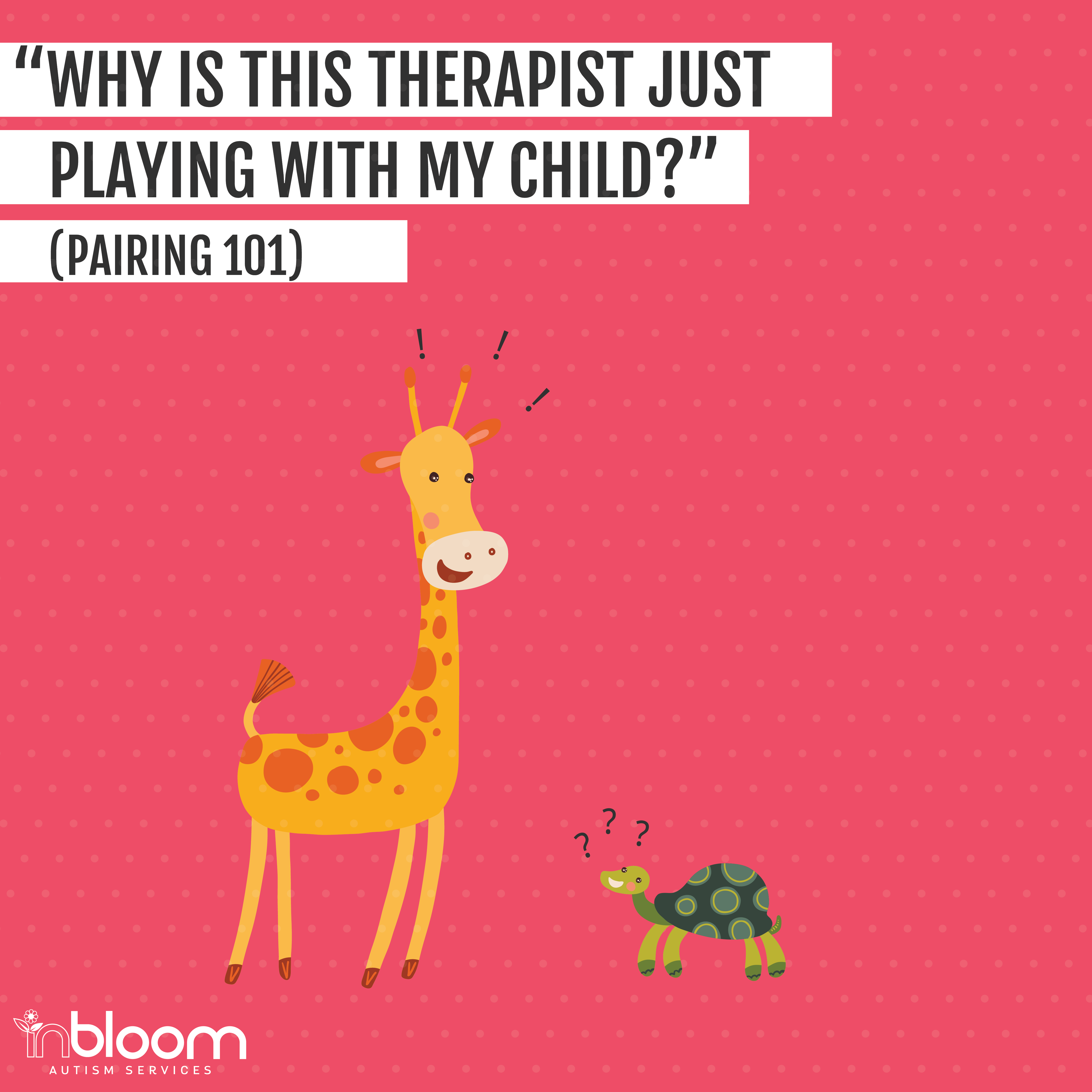June 5, 2019
“Why Is This Therapist Just Playing with My Child?”

Priorities, Priorities…
When a new therapist is working with your child, their first priority is pairing. Your BCBA will prepare you for what to expect during the first week of therapy. We like to give our kiddos clear expectations; and we also want to do that for the parents! To put it simply: pairing is creating a positive relationship between the therapist and your child. Although the pairing process is ongoing throughout the course of therapy, it is particularly important during the first week or so. The therapist will create an enriched environment throughout the session and provide free access to the items and activities that your child loves.
First thing’s first: let’s talk about reinforcement! Reinforcement is any stimulus that will increase the likelihood of a behavior occurring again. An important thing to remember is that reinforcement looks different for everyone. Sarah may be reinforced by high fives, but Bobby may hate physical touch (e.g., high fives). Therefore, you wouldn’t want to deliver a high five to Bobby after desired behaviors, because it wouldn’t increase the behavior occurring in the future.
In other words, your therapist will become associated with the child’s favorite items and activities.
The goal of pairing is for the therapist to become a ‘conditioned reinforcer.’ In other words, your therapist will become associated with the child’s favorite items and activities. We want your child to learn that those items and activities are even more fun when the therapist, mom, dad, peer, etc. is there to engage with him/her. In doing this, when your therapist walks through the door, your kiddo will be excited and associate their presence with good things! – Our motto: “We want the child to run TO the therapist, not away from the therapist!”
Once the therapist, or caregiver, has become a conditioned reinforcer, the child will be much more motivated to comply with demands presented to him/her. You can gradually start increasing demands as the pairing sessions continue. It is likely that the child will not even notice they are working!
Here are some ways to improve a pairing session with a kiddo:
· Demands? Never heard of them! It may seem surprising, but asking questions to kiddos may actually present itself as a demand. It’s natural to immediately fire off questions when we first meet someone and we are trying to get to know them. But asking things like “What’s your favorite color?” or “What’d you do at school today?” are demands. Let the child lead the pairing session! With that being said, rather than saying “Follow me!”, you can let the child lead the way and use that opportunity to see what motivates them.
· Narration. Rather than asking questions, which may present as a demand, narrate the environment! Instead of saying “Where’d you get that cool Batman shirt?”, try saying “Woah, Batman!! He is the coolest, I love your shirt!”.
· Deprive the Preferred. Limit your child’s access to highly preferred toys, activities, and games, and bring them out when the therapist arrives. That way your child will have a higher motivation to engage with the therapist and their favorite things.
· Pairing is the Name, FUN is the Game. Have a good time! If you are not having a good time, your kiddo is most likely not having fun either. Be energetic, enthusiastic, and pretend that Batman shirt is the COOLEST shirt you have ever seen, even if you are more of a Spiderman fan. Deliver as much reinforcement as you can during these pairing sessions.
· Watch your Delivery. So you are going to follow the child’s lead and place little to no demands, and deliver a ton of reinforcement. However, there must be some limitations in regards to the delivery preferred activities, games, and toys. In other words, if the child is engaging in problem behavior or even moving away from you, you would not want to give the preferred item at that time. Giving a preferred item while the child is moving away or engages in problem behavior may reinforce that behavior and therefore increase its likelihood to occur in the future.
· Gaining Control. Without grabbing items from the child, try to gain control of their current reinforcer. For example, if they are on the swing, you can be the one pushing! Or if they are coloring with markers, you can hold the pack of markers and make statements as you hand colors over like “Wow, a blue marker, just like your favorite color!” Remember your child should not be required to request access to the preferred item. You are providing free access!
The first part (about 10-15 minutes, depending on the child) of any ABA session should be spent pairing.
Gradually start increasing demands as the pairing sessions continue. It is likely that the child will not even notice they are working! It is also important to keep in mind that pairing must continue after the initial pairing sessions. The first part (about 10-15 minutes, depending on the child) of any ABA session should be spent pairing. Even after a therapist is paired as a conditioned reinforcer, it is still not ideal to come into the session and immediately begin throwing demands and tasks at the kid.


